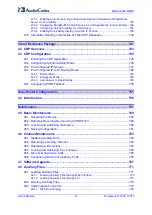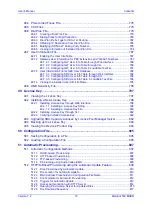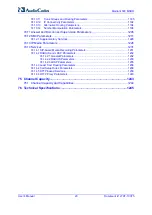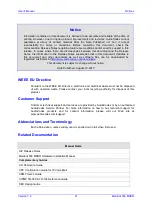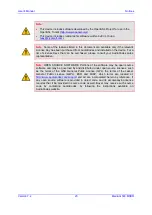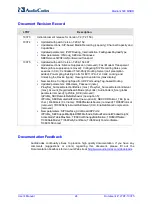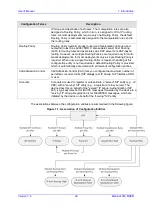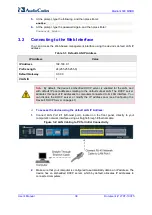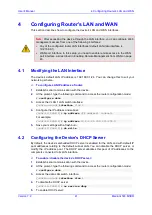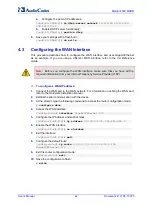
Version 7.2
27
Mediant 500 MSBR
User's Manual
1. Introduction
1.3.1
SBC Application
The objective of your configuration is to enable the device to forward calls between
telephony endpoints in the SIP-based Voice-over-IP (VoIP) network. The endpoints (SIP
entities) can be servers such as SIP proxy servers and IP PBXs, or end users such as IP
phones. In the SIP world, the endpoints are referred to as SIP user agents (UA). The UA
that initiates the call is referred to as the user agent client (UAC); the UA that accepts the
call is referred to as the user-agent server (UAS).
The following table describes the main configuration concepts and terminology.
Table
1-2: Configuration Concepts and Terminology
Configuration Terms
Description
IP Group
The IP Group is a logical representation of the SIP entity (UA) with which
the device receives and sends calls. The SIP entity can be a server (e.g.,
IP PBX or SIP Trunk) or it can be a group of users (e.g., LAN IP phones).
For servers, the IP Group is typically used to define the address of the
entity (by its associated Proxy Set). IP Groups are used in IP-to-IP routing
rules to denote the source and destination of the call.
Proxy Set
The Proxy Set defines the actual address (IP address or FQDN) of SIP
entities that are servers (e.g., IP PBX). As the IP Group represents the SIP
entity, to associate an address with the SIP entity, the Proxy Set is
assigned to the IP Group. You can assign the same Proxy Set to multiple
IP Groups (belonging to the same SRD).
SIP Interface
The SIP Interface represents a Layer-3 network. It defines a local listening
port for SIP signaling traffic on a local, logical IP network interface. The
term
local
implies that it's a logical port and network interface on the
device. The SIP Interface is used to receive and send SIP messages with
a specific SIP entity (IP Group). Therefore, you can create a SIP Interface
for each SIP entity in the VoIP network with which your device needs to
communicate. For example, if your VoIP network consists of three SIP
entities -- a SIP Trunk, a LAN IP PBX, and remote WAN users -- a SIP
Interface can be created for each of these Layer-3 networks.
The SIP Interface is associated with the SIP entity, by assigning it to an
SRD that is in turn, assigned to the IP Group of the SIP entity.
Media Realm
The Media Realm defines a local UDP port range for RTP (media) traffic on
any one of the device's logical IP network interfaces. The Media Realm is
used to receive and send media traffic with a specific SIP entity (IP Group).
The Media Realm can be associated with the SIP entity, by assigning the
Media Realm to the IP Group of the SIP entity, or by assigning it to the SIP
Interface associated with the SIP entity.
SRD
The SRD is a logical representation of your entire SIP-based VoIP network
(Layer 5) containing groups of SIP users and servers. The SRD is in effect,
the foundation of your configuration to which all other previously mentioned
configuration entities are associated. For example, if your VoIP network
consists of three SIP entities -- a SIP Trunk, a LAN IP PBX, and remote
WAN users -- the three SIP Interfaces defining these Layer-3 networks
would all assigned to the same SRD.
Typically, only a single SRD is required and this is the recommended
configuration topology. As the device provides a default SRD, in a single
SRD topology, the device automatically assigns the SRD to newly created
configuration entities. Thus, in such scenarios, there is no need to get
Summary of Contents for Mediant 500 MSBR
Page 2: ......
Page 33: ...Part I Getting Started with Initial Connectivity ...
Page 34: ......
Page 36: ...User s Manual 36 Document LTRT 10375 Mediant 500 MSBR This page is intentionally left blank ...
Page 40: ...User s Manual 40 Document LTRT 10375 Mediant 500 MSBR This page is intentionally left blank ...
Page 45: ...Part II Management Tools ...
Page 46: ......
Page 48: ...User s Manual 48 Document LTRT 10375 Mediant 500 MSBR This page is intentionally left blank ...
Page 115: ...Part III General System Settings ...
Page 116: ......
Page 132: ...User s Manual 132 Document LTRT 10375 Mediant 500 MSBR This page is intentionally left blank ...
Page 137: ...Part IV General VoIP Configuration ...
Page 138: ......
Page 290: ...User s Manual 290 Document LTRT 10375 Mediant 500 MSBR This page is intentionally left blank ...
Page 306: ...User s Manual 306 Document LTRT 10375 Mediant 500 MSBR This page is intentionally left blank ...
Page 380: ...User s Manual 380 Document LTRT 10375 Mediant 500 MSBR This page is intentionally left blank ...
Page 454: ...User s Manual 454 Document LTRT 10375 Mediant 500 MSBR This page is intentionallty left blank ...
Page 455: ...Part V Gateway Application ...
Page 456: ......
Page 460: ...User s Manual 460 Document LTRT 10375 Mediant 500 MSBR This page is intentionally left blank ...
Page 484: ...User s Manual 484 Document LTRT 10375 Mediant 500 MSBR This page is intentionally left blank ...
Page 494: ...User s Manual 494 Document LTRT 10375 Mediant 500 MSBR This page is intentionally left blank ...
Page 625: ...Part VI Session Border Controller Application ...
Page 626: ......
Page 654: ...User s Manual 654 Document LTRT 10375 Mediant 500 MSBR This page is intentionally left blank ...
Page 656: ...User s Manual 656 Document LTRT 10375 Mediant 500 MSBR This page is intentionally left blank ...
Page 741: ...Part VII Cloud Resilience Package ...
Page 742: ......
Page 751: ...Part VIII Data Router Configuration ...
Page 752: ......
Page 753: ......
Page 754: ......
Page 756: ...User s Manual 756 Document LTRT 10375 Mediant 500 MSBR This page is intentionally left blank ...
Page 757: ...Part IX Maintenance ...
Page 758: ......
Page 834: ...User s Manual 834 Document LTRT 10375 Mediant 500 MSBR This page is intetnionaly left blank ...
Page 837: ...Part X Status Performance Monitoring and Reporting ...
Page 838: ......
Page 848: ...User s Manual 848 Document LTRT 10375 Mediant 500 MSBR This page is intentionally left blank ...
Page 852: ...User s Manual 852 Document LTRT 10375 Mediant 500 MSBR This page is intentionally left blank ...
Page 854: ...User s Manual 854 Document LTRT 10375 Mediant 500 MSBR This page is intentionally left blank ...
Page 878: ...User s Manual 878 Document LTRT 10375 Mediant 500 MSBR This page is intentionally left blank ...
Page 880: ...User s Manual 880 Document LTRT 10375 Mediant 500 MSBR This page is intentionally left blank ...
Page 926: ...User s Manual 926 Document LTRT 10375 Mediant 500 MSBR This page is intentionally left blank ...
Page 927: ...Part XI Diagnostics ...
Page 928: ......
Page 950: ...User s Manual 950 Document LTRT 10375 Mediant 500 MSBR This page is intentionally left blank ...
Page 954: ...User s Manual 954 Document LTRT 10375 Mediant 500 MSBR This page is intentionally left blank ...
Page 956: ...User s Manual 956 Document LTRT 10375 Mediant 500 MSBR This page is intentionally left blank ...
Page 958: ...User s Manual 958 Document LTRT 10375 Mediant 500 MSBR This page is intentionally left blank ...
Page 974: ...User s Manual 974 Document LTRT 10375 Mediant 500 MSBR This page is intentionally left blank ...
Page 976: ...User s Manual 976 Document LTRT 10375 Mediant 500 MSBR This page is intentionally left blank ...
Page 977: ...Part XII Appendix ...
Page 978: ......
Page 982: ...User s Manual 982 Document LTRT 10375 Mediant 500 MSBR This page is intentionally left blank ...


